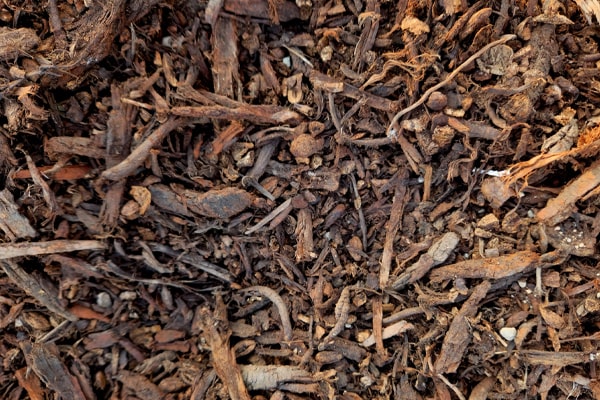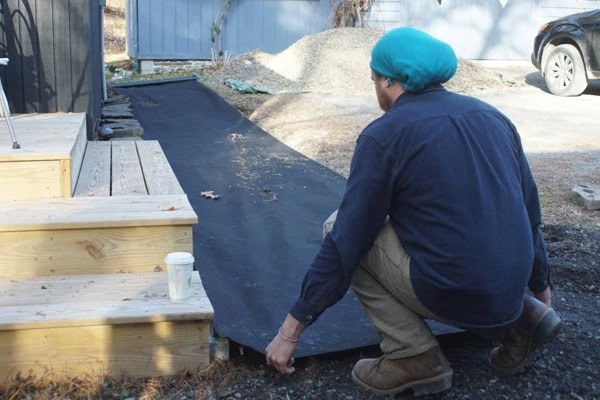While no doubt effective, chemical weed products can harm desirable plants and animals. Worse, it can leach chemicals into the soil and end up on your plate. By prioritizing eco-friendly weed control practices and products, we can minimize the negative impact on biodiversity, preserving the delicate balance of ecosystems, including:
Protecting garden pollinators: Many herbicides used in conventional weed control have been linked to declines in pollinator populations, such as bees and butterflies. Choosing environmentally friendly alternatives helps protect these essential pollinators, which are crucial for the reproduction of many plant species and the overall health of ecosystems.
Prevent water pollution: Chemical herbicides can leach into soil and waterways, contaminating groundwater and surface water sources. This pollution can have detrimental effects on aquatic life and human health. Environmentally friendly weed control methods help safeguard water quality by reducing the use of harmful chemicals.
Preserve soil health: Some herbicides can disrupt soil microbial communities and degrade soil quality over time. By adopting sustainable weed control practices, such as mulching, hand weeding, or using natural herbicides, we can maintain soil health and fertility, ensuring the long-term productivity of agricultural land.
Minimize risk to human health: Pesticides and herbicides used in conventional weed control have been associated with various health risks for humans, including respiratory problems, neurological disorders, and certain cancers. By promoting safer alternatives, we can minimize exposure to harmful chemicals and protect public health.
Resilience to climate change: Ecosystems that are healthy and diverse are better equipped to withstand the impacts of climate change, such as extreme weather events and shifting temperature patterns. Prioritizing weed control methods that support ecosystem resilience can help mitigate the effects of climate change on both natural and agricultural landscapes.
Contents []
Eco-Friendly Weed Control Practices to Try
Going chemical-free? Here are practices that will reduce weeds in the garden without harming the environment or human health:
Flame weeding
Flame weeding is a method of using heat to kill weeds.
You will need a special tool called a flame weeder for this method. It’s kind of like a long metal pole with a burner at the end. This burner produces a hot flame, similar to the flame on a gas stove.
When a farmer or gardener wants to get rid of weeds, they take the flame weeder and pass it over the weeds. The intense heat from the flame quickly heats up the weeds, causing the water inside them to turn into steam. This steam bursts the cells inside the weeds, essentially cooking them from the inside out.
The high temperature also damages the leaves and stems of the weeds, making them wither and die. It’s like giving the weeds a really bad sunburn!
Flame weeding is often done in rows between crops or in areas where there are lots of weeds but no desirable plants nearby. It’s important to be careful when using flame weeding because the heat can also damage or kill nearby plants if they’re not resistant to high temperatures.
Solarization
Solarization is a chemical-free method used to kill weeds and other unwanted plants in the soil. It works by harnessing the power of the sun to create heat that is lethal to weeds.
To do this, prepare the area where the weeds are growing by removing any debris, rocks, or large plants. The soil is then smoothed out to create an even surface.
Next, a clear plastic sheet, usually made of polyethylene, is spread over the prepared area and secured tightly around the edges to prevent any heat from escaping.
Once the plastic is in place, the sun’s rays pass through it and heat up the soil underneath. As the temperature rises, it becomes hot enough to kill weed seeds, seedlings, and even some types of plant diseases.
The heat trapped under the plastic also creates a sort of greenhouse effect, further increasing the temperature and ensuring that the weeds are exposed to intense heat for an extended period.
Solarization typically takes several weeks to be effective, depending on factors such as the intensity of the sun’s rays, the thickness of the plastic, and the type of weeds being targeted.
During this time, the weeds are deprived of light, water, and oxygen, which are essential for their growth and survival. Without these resources, the weeds weaken and eventually die off.
After the solarization process is complete, the plastic is removed, and the soil is left weed-free and ready for planting.
Mulching

Mulching involves covering the soil around plants with a layer of material like straw, leaves, or wood chips over the soil.
When you spread mulch over the soil, it forms a protective barrier that blocks sunlight from reaching weed seeds. Without sunlight, weed seeds can’t sprout and grow. Mulch also helps retain moisture in the soil, which is good for plants but not so great for weeds. Weeds need sunlight and water to grow, so when you deprive them of these things by mulching, they have a hard time surviving.
Mulch raises and lowers the soil temperature, keeping it warm in the winter and cool in the summer. This helps create a comfortable environment for beneficial microbes and insects that live in the soil and help plants grow. These helpful critters compete with weeds for space and nutrients, making it harder for weeds to take hold.
Another way mulch helps control weeds is by smothering them. As the mulch breaks down over time, it creates a layer of organic matter on top of the soil. This layer can be thick enough to suffocate small weed seedlings, preventing them from growing.
Besides keeping weeds at bay, mulching is good for the soil and helps conserve water. Plus, as the mulch breaks down, it adds nutrients to the soil, making it healthier for your plants.
Landscape Fabric

Landscape fabric is a material used to control weeds without using chemicals. It’s like a big, sturdy blanket that you lay down on the soil in your garden or landscape beds. To install weed barrier landscape fabric, follow these steps:
- Prepare the area where you want to use landscape fabric by removing any existing weeds and debris. Then, you spread the fabric over the soil and cut holes in it where you want to plant your flowers, shrubs, or other plants.
The landscape fabric blocks sunlight from reaching the soil underneath, which prevents weed seeds from sprouting and growing. Without sunlight, weeds can’t photosynthesize and make food, so they eventually die off.
But here’s the cool part: even though landscape fabric blocks sunlight, it still lets air, water, and nutrients pass through to the soil. This means your plants can still get everything they need to grow big and strong, but the weeds can’t.
Landscape fabric is usually made of a woven material, like polypropylene or polyester, that’s strong enough to withstand the elements but porous enough to allow water and air to flow through.
Some people also use mulch on top of landscape fabric to make it look nicer and help hold it in place. This combination of landscape fabric and mulch is a great way to keep weeds under control in your garden or landscape beds without using harmful chemicals.
And because landscape fabric is durable and long-lasting, it can save you time and money in the long run by reducing the need for weeding and maintenance.
Cover Crops
Cover crops are plants grown to cover and protect soil in gardens or fields when they’re not being used for main crops. They act like natural blankets, shielding the soil from sunlight and preventing weed seeds from sprouting and growing. These plants work as cover plants to suppress weeds:
- Clover
- Hairy vetch
- Rye grass
- Buckwheat
- Winter peas
- Crimson clover
- Annual ryegrass
- Radishes
- Alfalfa
- Oats
Cover crops have extensive root systems that help break up compacted soil, allowing air, water, and nutrients to penetrate deep into the ground. This improves soil structure and fertility, making it healthier for future crops.
When cover crops are cut down or die, they decompose and add organic matter to the soil. The organic matter enriches the soil, providing nutrients for subsequent crops and promoting overall soil health.
Certain cover crops, such as clover and hairy vetch, have the ability to capture nitrogen from the air and store it in their roots. When these plants decompose, they release nitrogen into the soil, acting as a natural fertilizer for other plants.
Kitchen Solutions
Weed-killing recipes with vinegar, salt, and dish soap are popular alternatives to chemical herbicides for controlling weeds without harming the environment.
Vinegar, especially white vinegar with a high concentration of acetic acid, can be an effective weed killer. When sprayed directly onto weeds, the acetic acid in vinegar acts as a desiccant, causing the plant cells to dry out and leading to the death of the weeds. However, it’s essential to use caution when using vinegar as it can also affect nearby plants, including desirable ones.
On the other hand, salt can dehydrate and kill weeds by drawing moisture out of their cells when applied in high concentrations. It disrupts the balance of water and nutrients within the plant, ultimately killing weeds.
However, salt can remain in the soil for an extended period, making it difficult for plants to grow in that area in the future. That’s why it’s crucial to use salt sparingly and avoid applying it in areas where you plan to grow other plants.
Dish soap can enhance the effectiveness of vinegar or salt as natural weed killers. The soap helps the solution adhere to the leaves of the weeds, ensuring better coverage and absorption. Additionally, the surfactant properties of dish soap can break down the waxy layer on the leaves of weeds, making them more susceptible to dehydration and damage.
These kitchen solutions offer a non-toxic and environmentally friendly alternative to chemical herbicides. But it’s important to use them carefully to avoid unintended harm to desirable plants and the surrounding ecosystem.
Additionally, while these methods can be effective for controlling weeds in small areas or between cracks in pavement, they may not be suitable for big gardens or fields.
As you can see, it’s possible to go chemical-free when it comes to controlling weeds in the garden. By making environmentally friendly weed control a priority, we can create healthier and more sustainable landscapes for future generations.



